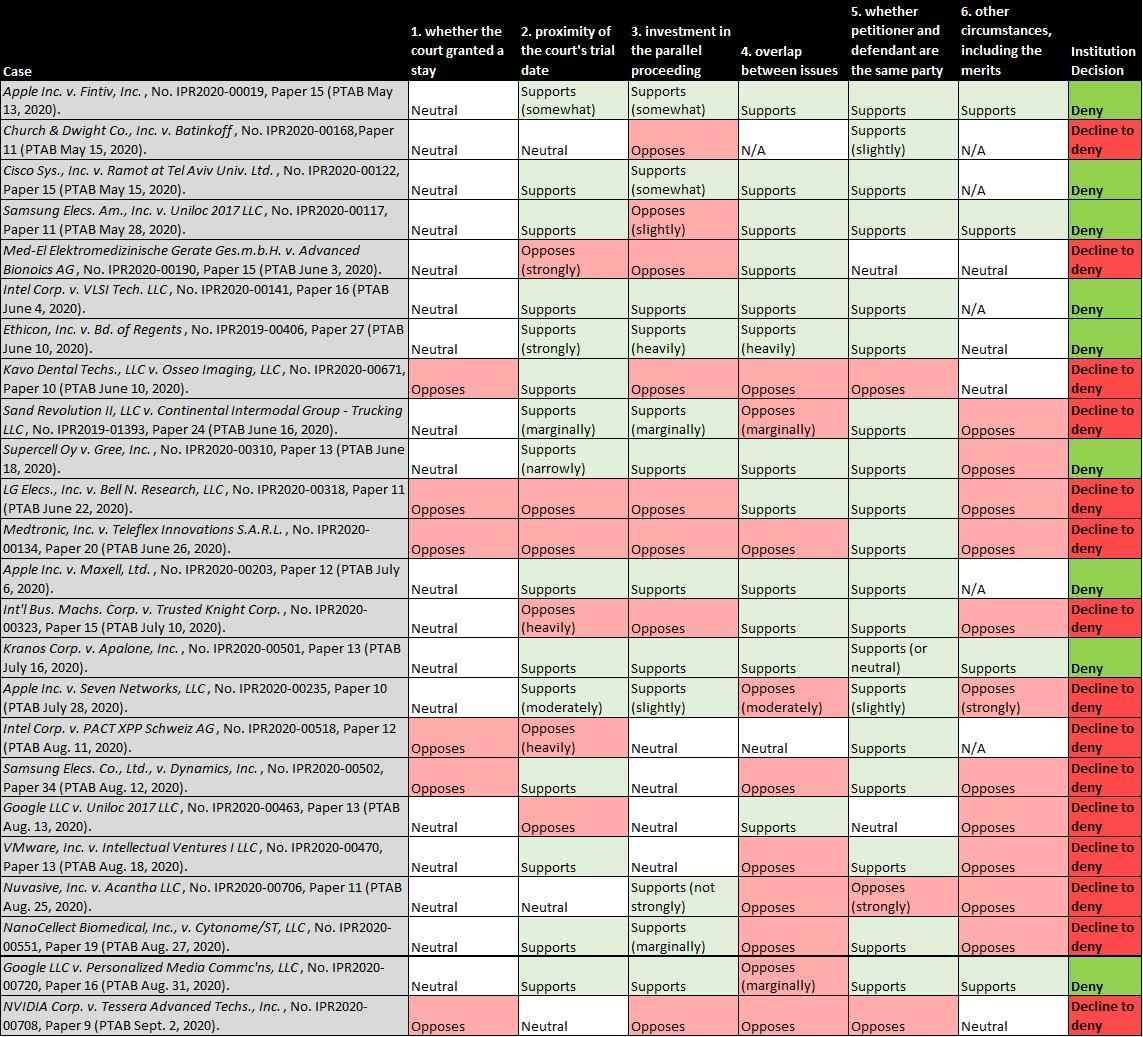An Initial Statistical Analysis of the PTAB’s Recent “NHK-Fintiv Factor” Institution Decisions
Sep 22 2020
This article originally was published by Law360.
The PTAB has recently garnered significant attention for denying a spate of IPR petitions in which the challenged patent is also subject to parallel district court litigation. In these cases, the PTAB has invoked the so-called “NHK-Fintiv rule,” which originates from two precedential PTAB decisions, NHK Spring Co. v. Intri-Plex Techs., Inc.1 and Apple Inc. v. Fintiv, Inc.,2 in which the PTAB applied the rule and then exercised its discretion to deny institution of the IPR trials.
The NHK-Fintiv rule has now been applied by the PTAB in two dozen cases, providing a small but potentially informative statistical sample size. In view of the impact that this now precedential rule has had on PTAB practice in the last few months, the discussion below endeavors to provide a high-level statistical analysis of how the PTAB has sought to balance the six NHK-Fintiv factors in reaching its post-Fintiv institution decisions. An analysis of those decisions reveals that some factors (grouped into three “tiers” herein) are more determinative of the PTAB’s institution decision than others. Further, if each factor is assigned a unique statistical weight, this analysis further reveals that institution decision outcomes do not directly follow a simple tabulation of factors “supporting” and “opposing” discretionary denial of institution, but typically rely on more complex inter-factor support in the institution decision.
In its precedential Fintiv decision, the PTAB, expanding on its precedent in NHK, considered the following six factors for discretionary denial of an IPR petition under 35 U.S.C. § 314(a):
As of September 2, 2020, the PTAB had considered the foregoing NHK-Fintiv factors in determining whether to exercise its discretion to deny institution in at least twenty-four IPR cases.4 The appended chart summarizes how the PTAB weighed each factor in rendering its institution decision in each of those cases.
The following discussion analyzes the PTAB’s institution decisions based on two distinct statistical metrics formulated and evaluated herein:
This two-dimensional statistical analysis attempts to provide insights into how the PTAB evaluates and weighs each of the six NHK-Fintiv factors from a macro perspective, irrespective of the specific and unique facts of each case.
Tier 1 Factors:
Factor 4 (record: 17-5-2; weight: 36%)
Factor 6 (record: 14-1-9; weight: 53%)
In the twenty-four post-Fintiv cases studied, Factors 4 and 6 are the most determinative NHK-Fintiv factors in the PTAB’s discretionary denial analysis. Frequently, the PTAB’s institution decision reflects its findings with respect to these two factors (seventeen times for Factor 4 and fourteen times for Factor 6). Further, the PTAB rarely issues a decision that is inconsistent with its findings on these two factors (five times for Factor 4 and one time for Factor 6), and in none of the institution decisions did the PTAB arrive at a conclusion that was inconsistent with its findings on both of these factors. The strengths of these two factors are further demonstrated by their weights of 36% and 53%, respectively. For example, Factor 6’s weight of 53% means that, on average, when the PTAB relied on this factor as part of its institution decision, more than half of the PTAB’s support for its decision came from Factor 6. Thus, Factor 6 depended on less mutual support and/or faced more opposition than any other factor.
On multiple occasions, the PTAB has relied entirely on Factors 4 and 6 in reaching its institution decision, despite the presence of two or even three opposing factors. For example, in Sand Revolution II, LLC v. Continental Intermodal Group - Trucking LLC, No. IPR2019-01393, Paper 24 (PTAB June 16, 2020), although the PTAB found Factors 2, 3, and 5 supported denial of institution, and considered Factor 1 neutral, the PTAB nonetheless instituted the IPR, finding Factor 4 marginally opposed denial of institution where “Petitioner [] stipulated . . . that, if the IPR is instituted, Petitioner [would] not pursue the same grounds in the district court litigation,” and Factor 6 supported institution where “Petitioner [] set forth a reasonably strong case for the obviousness of most challenged claims.”5
Tier 2 Factors:
Factor 2 (record: 15-6-3; weight: 34%)
Factor 3 (record: 15-5-4; weight: 30%)
The PTAB has afforded Factors 2 and 3 moderate determinative value in its overall discretionary denial analysis. The PTAB’s findings with respect to Factors 2 and 3, which are rarely neutral, often reflect the outcome of the PTAB’s institution decision. However, these factors tend to rely on more mutual support from the other factors (on average, Factors 2 and 3 are only weighted about one-third in the PTAB’s institution decision) than do Tier 1 Factors 4 and 6.
For example, in Kranos Corp. v. Apalone, Inc., No. IPR2020-00501, Paper 13 (PTAB July 16, 2020), the PTAB found that Factors 2 and 3 supported denial of institution where “the district court’s trial date [preceded] the Board’s statutory deadline for issuing a final written decision by at least ten months” and “[i]n view of the parties’ completion of contentions, discovery, and dispositive motions in the related district court litigation, the parties ha[d] made a substantial investment in the parallel proceeding.” In reaching its decision to deny institution, however, the PTAB found that Factors 4-6 also supported denial of institution.
Tier 3 Factor:
Factor 1 (record: 6-0-18; weight: 39%)
Factor 5 (record: 12-10-2; weight: 27%)
The PTAB has generally afforded the least determinative value to Factors 1 and 5. Factor 1 is somewhat of an outlier in this analysis because the PTAB often resolves this factor as neutral (eighteen times) and generally does not rely upon it in the institution decision, even in situations where the district court has already denied a motion for a stay. With Factor 5 almost evenly split between its consistency and inconsistency with the institution decision, very little information can be gleaned from reviewing Factor 5 in isolation. Further, even when the PTAB’s finding on Factor 5 reflects the outcome of the institution decision, the PTAB only places about a quarter of its reliance on this factor.
For example, in deciding to deny institution in Apple Inc. v. Maxell, Ltd., No. IPR2020-00203, Paper 12 (PTAB July 6, 2020), the PTAB found Factor 1 to be neutral even where the district court denied the petitioner’s motion for a stay without prejudice, and found that Factor 5 supported denial of institution where “[b]oth parties acknowledge that Petitioner here is the defendant in the underlying litigation.” But the PTAB further found that Factors 2-4 also supported denial of institution, and did not find that any factors opposed discretionary denial. Thus, it is difficult to say how much of a role Factor 5 played in the PTAB’s decision.
After statistically evaluating the twenty-four post-Fintiv IPR institution decisions, the Tier 1 factors (Factors 4 and 6) are typically more determinative of the PTAB’s institution decision than the Tier 2 factors (Factors 2 and 3) and Tier 3 factors (Factors 1 and 5). Further, the Tier 1 Factors tend to require less mutual support from the other factors in the institution decision, that is, Tier 2 and Tier 3 factors typically rely upon more complex inter-factor support in the institution decision. So while each case is factually unique and the PTAB’s application of the NHK-Fintiv rule continues to develop, this statistical framework may assist in evaluating which factors to emphasize when presenting the issues to the PTAB.

1 IPR2018-00752, Paper 8 (PTAB Sept. 12, 2018) (precedential).
2 IPR2020-00019, Paper 15 (PTAB May 13, 2020) (precedential) [hereinafter “Fintiv”].
3 Fintiv, Paper 15 at 7-8 (citing NHK, Paper 8).
4 For purposes of this analysis, multiple IPRs involving the same parties but challenging different patents were treated as a single case when the PTAB issued institution decisions with the same analysis of the NHK-Fintiv factors.
5 See also Apple Inc. v. Seven Networks, LLC, No. IPR2020-00235, Paper 10 (PTAB July 28, 2020) (instituting trial where Factors 2, 3, and 5 supported denial of institution and only Factors 4 and 6 opposed denial of institution); NanoCellect Biomedical, Inc., v. Cytonome/ST, LLC, No. IPR2020-00551, Paper 19 (PTAB Aug. 27, 2020) (same); VMware, Inc., v. Intellectual Ventures I LLC, No. IPR2020-00470, Paper 13 (PTAB Aug. 18, 2020) (instituting trial where Factors 2 and 5 supported denial of institution and only Factors 4 and 6 opposed denial of institution).